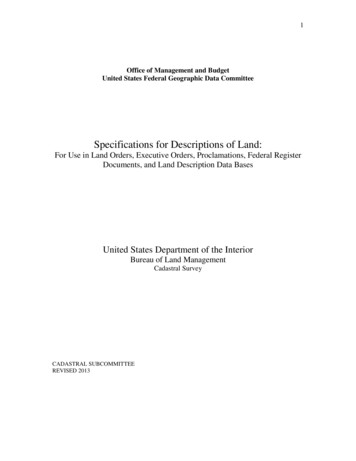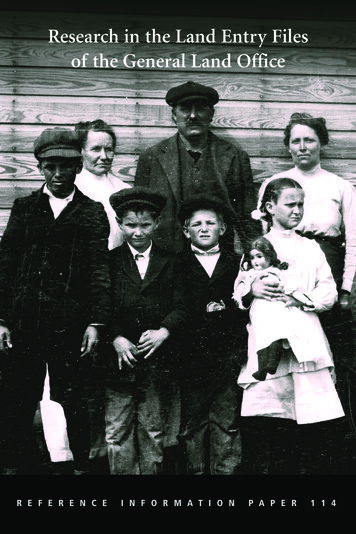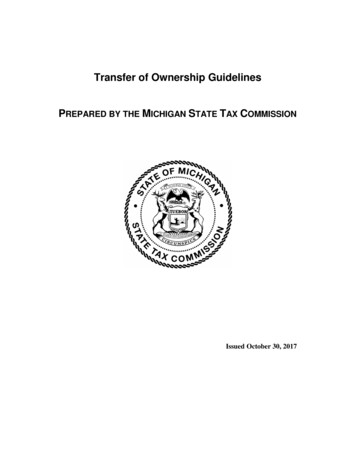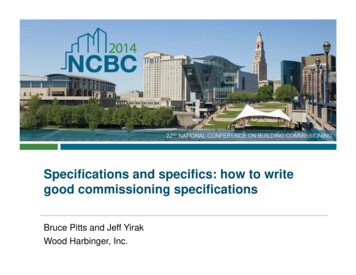
Transcription
1Office of Management and BudgetUnited States Federal Geographic Data CommitteeSpecifications for Descriptions of Land:For Use in Land Orders, Executive Orders, Proclamations, Federal RegisterDocuments, and Land Description Data BasesUnited States Department of the InteriorBureau of Land ManagementCadastral SurveyCADASTRAL SUBCOMMITTEEREVISED 2013
2Specifications for Descriptions of Land:For Use in Land Orders, Executive Orders, Proclamations,Federal Register Documents, and Land Description Data BasesWASHINGTON: 2013U.S. DEPARTMENT OF THE INTERIORFor sale by the Public Land Survey System Foundationhttp://www.blmsurveymanual.org/
3U.S. DEPARTMENT OF THE INTERIORAs the Nation's principal conservation agency, the Department of the Interior(Department) has basic responsibilities for water, fish, wildlife, mineral, land, park, andrecreational resources. Indian and Territorial affairs are other major concerns ofAmerica's “Department of Natural Resources.”The Department works to assure the wisest choice in managing all of the nation’sresources so each will make its full contribution to a better United States – now and in thefuture.The Department manages about 500 million acres, or one-fifth, of the land in theUnited States. The Bureau of Land Management (BLM) manages more than 245 millionsurface acres and also administers more than 700 million acres of subsurface mineralestate and in all 50 States.The BLM is the Nation’s surveyor and maintains extensive current and historicalinformation about land ownership in the United States. Most title to land, public orprivate, begins with a land description established by an original cadastral survey.Security of legal title to land is the fundamental object of the cadastral surveyor’s work.It is more important now than in the past that the person preparing landdescriptions be knowledgeable of requirements for the preparation of the various types ofland descriptions. It is necessary to use the proper format, terms and phrases, and intentwith qualification to assure the content of the land description is free of ambiguity. Theambiguous descriptions of the past are the boundary disputes of the future.Previous editions of Specifications for Descriptions of Tracts of Land for Use inExecutive Orders and Proclamations were issued in 1931, re-issued in 1941 withcorrections as to procedure, revised in 1942, and reprinted without revision in 1960. In1979 the Specifications was revised and the title was changed to Specifications forDescriptions of Tracts of Land for Use in Land Orders and Proclamations.
4CONTENTSChapterPageINTRODUCTION AND PURPOSE OF THIS PUBLICATION1.LAND DESCRIPTIONSGeneral Considerations - PurposeAuthorityDescriptions of LandTypes of DescriptionsDescription by Reference to Official Records2.THE PUBLIC LAND SURVEY SYSTEMRectangular SurveysPreferred OrderThe Preferred Method for the Writing of DescriptionsAreaConventional Symbols and AbbreviationsExamples of Descriptions of Lands based upon the Rectangular Surveys of thePublic Land Survey System3.METES-AND-BOUNDSNatural and Artificial BoundariesAreaThe Parts of Metes-and-Bounds DescriptionsExamplesCaption or PreambleBodyClausesStrip DescriptionsAmbulatory Descriptions4.LOT AND BLOCK DESCRIPTIONS5.ILLUSTRATIONS (MAPS) AND COORDINATESMaps to be PublishedSurvey Plats, Maps or Diagrams Forming Official SupplementsDescription by CoordinatesGeographic PositionsExamples of Geographic Coordinate Positions6.FORM AND ARRANGEMENTTitlesProclamationsPublic Land OrdersExecutive Order No. 11030, as AmendedPreparation, Presentation, Filing, and Publication of Executive Orders andProclamationsApplicable to All Documents Filed with Federal RegisterApplicable to All Proposed Executive Orders and ProclamationsExecutive Order No. 10355
5Federal Land Policy and Management Act Withdrawal, Reservation andClassification of LandsDepartment of the Interior Secretary’s OrdersExecutive Order No. 13327Federal Real Property Asset ManagementMarine Managed Areas: Best Practices for Boundary MakingINTRODUCTION TO PREVIOUS EDITIONS
6INTRODUCTION AND PURPOSE OF THIS PUBLICATIONThe Federal Board of Surveys and Maps (Board) was established by Executiveorder in 1919, to coordinate and promote improved surveying and mapping activities byFederal agencies. In 1930, the Department of State requested the Board to prepare rulesand specifications for descriptions of tracts of land appropriate for use in Executiveorders and Proclamations. The original edition, entitled, Specifications for Descriptionsof Tracts of Land for Use in Executive Orders and Proclamations, was completed andpublished in 1931, with subsequent editions issued in 1941, 1942, 1960, and 1979. Since1931, the Specifications have served the vital function of providing guidance to thosewho must write and interpret land descriptions and have been used by experts in the legal,survey, public administration, and geospatial data analyst professions.A boundary is the fixing of a limit or extent of property and in this publication isassociated with uplands, inland waters, and tidelands with application to marineboundaries. When an Executive department or any agency or establishment of theFederal Government describes or specifies any parcel of land or marine area by boundaryor subdivisional unit, the description should be a model of precision, to the extent theavailable record data permit. A law, regulation or order cannot fulfill its intended effectif the boundary description is inaccurate, vague or ambiguous.This publication will provide guidance for writing accurate boundary descriptions,locations by survey, the form and arrangement to be followed for Executive and PublicLand Orders and Proclamations, and examples of boundary descriptions. Use of thispublication will provide a standardized process for review of descriptions to assure thatonly the best available descriptions are published.Many land descriptions are used to develop products for Federal administrativepurposes. To facilitate the sharing of land description information in an electronic database format, all data sets should be accompanied with essential cadastral metadata thatconforms to the Federal Geographic Data Committee (FGDC) Subcommittee forCadastral Data FGDC Metadata Data Content Standard and Publication Standard. Coredata is the minimal set of information needed for sharing data among agencies for initialsearch and discovery by the user community and use in basic business operations.The database content definitions for land descriptions are found in the FGDCCadastral Data Content Standard. The data content standard provides the logical designdefinitions and relationship of land description elements. Physical implementationsshould be consistent and compliant with the standard’s definitions and intent.Accurate and precise geographic (or geospatial) information is critical to promoteeconomic development, improve stewardship of natural resources, and protect theenvironment. Standardized land descriptions avoid wasteful duplication of effort andpromote effective and economical management of land and resources by Federalagencies. Since the publication of the 1979 Edition, certain procedures have beenrendered inapplicable due to reorganization and transfer of functions of various Federal
7Agencies.1 There are also new survey and digital applications and methods mandatingthis revision. Further experience in the use of the specifications, and improvements tosurvey and digital data collection during the near thirty-year period, which has elapsedsince the previous revision, has indicated the need for additional and updated explanatorytext and examples.Executive Order No. 12906, as amended, requires each agency to document allnew geospatial data it collects or produces, using the standard developed by the FGDC. 2Geospatial data mean information that identifies the geographic location andcharacteristics of natural or constructed features and boundaries on the earth. 3 Thegeospatial information necessary to describe the geographic extent and the rights andinterests include surveys, legal description reference systems, parcel-by-parcel surveys,and descriptions.4The Office of Management and Budget (OMB) assists the President in preparingthe budget, formulating fiscal programs, supervising the administration of the budget,conducting efficiency reviews of Executive branch organizational structure andmanagement procedures, assisting in clearing legislative proposals from Federalagencies, in drafting Executive orders and Presidential Proclamations, in developingregulatory reform programs, coordinating government activities, and advising thePresident on program progress.The FGDC was established by OMB Circular No. A-16, Coordination ofGeographic Information and Related Spatial Data Activities; Revised 2002, to coordinatethe Federal Government’s development, use, sharing and dissemination of geographicdata. The FGDC Cadastral Subcommittee is responsible for the standard that covers thedevelopment, maintenance, and dissemination of the core set of digital geospatialcadastral information (section 2(b)(1)), including descriptions of tracts of land.The term “land order” by common usage has come to mean “Executive order”and “Public Land Order.” The terms “legal description” and “land description” over thepast have commonly been used interchangeably. In reality the “legal description”contains the “land description” within the legal document or order. The “legaldescription” also defines the use, purpose, encumbrances, and/or time frame (4dimensional) of the tract(s) being described. The actual “land description” defines the1The policies and procedures for publication in the FEDERAL REGISTER are established by theAdministrative Committee of the Federal Register. The functions connected with the preparation andpresentation of Public Land Orders, Executive orders and Proclamations are carried on by the Office of theFederal Register, National Archives Records Administration, under the provisions of the Federal RegisterAct, as amended, and the Administrative Procedure Act. The pertinent regulations are published in Title 1of the Code of Federal Regulations. These entities have introduced certain changes in procedure andrequirements and have rendered inapplicable some of the material contained in the 1979 revision.2E.O. 13286 (02/28/03) 68 FR 10619 – Transfer of certain functions to the Secretary of HomelandSecurity.3E.O. 12906.4Federal Geographic Data Committee. 1997. Framework Introduction and Guide. p. 21.
8delimitation5 of an area of the subsurface, submerged lands, water column, water surface,land surface or air column, and 2-dimensional, or 3-dimensional limits.5Delimitation/delimited/delimiting means the determination of a boundary; includes all phases ofboundary development.
9Chapter ILAND DESCRIPTIONSGENERAL CONSIDERATIONSPURPOSEPublic Land Orders, Executive orders and Proclamations containing landdescriptions are usually designed to reserve and set apart certain tracts6 or areas owned orcontrolled by the Federal Government for specific public uses or purposes, or for Indiantrust responsibilities. These tracts or areas could be reserved or set apart for military andnaval requirements, national forests, parks and monuments, game and bird refuges,Indian or Alaska native lands, minerals development, various administrative uses, or forclassification in aid of proposed legislation. An initial action is ordinarily taken by thebureau or agency exercising administrative control or jurisdiction over the land.7A Proclamation is normally an announcement by the President of the UnitedStates issued to carry out the provisions of an Act of Congress. Proclamations are usuallyof wider public distribution than Public Land Orders and Executive orders, whichnormally apply to affairs of the Government, have a more limited and particular purpose,and are of a temporary nature or duration. An example of a Proclamation would be theestablishment of a new national monument. It is the practice to withdraw the land byExecutive order or Public Land Order preliminary to survey, examination, and permanentestablishment. Subsequent modification of the boundaries of such a reservation maybecome necessary, and the general practice is to accomplish these purposes by Executiveorder or Public Land Order. In some cases the authorizing legislation specifies themanner in which the action should be taken.All Proclamations are published in the United States Statutes at Large.Proclamations, Executive orders and Public Land Orders are published in the FederalRegister under the provisions of the Acts of July 26, 1935 (49 Stat. 500) and October 22,1968 (82 Stat. 1274; 44 U.S.C. 1505).AUTHORITYThe President has the power to reserve or withdraw lands owned or controlled bythe United States for public purposes. 6 Pub. Lands Dec. 317 states: “The President isvested with general authority in the matter of reserving for public uses, and lands so setapart is not subject to disposition under the public land laws during the existence of suchreservation.” Section 2, of the Act of June 8, 1906, (34 Stat. 225; 16 U.S.C. 431 et seq.)authorizes the President of the United States, in his discretion, to declare by publicproclamation historic landmarks, historic and prehistoric structures, and other objects of6The term “tract” by common usage is applied to an expanse of land of no particular size. In modernFederal land surveys, the term is used specifically to mean an expanse of land that lies in more than onesection or that cannot be identified in whole as part of a particular section. It is described by tract numberand township.7By Public Law 94-579 “Federal Land Policy and Management Act of 1976,” 90 Stat. 2743, 43 U.S.C.1701 et seq., the Secretary of the Interior is authorized to sign all orders withdrawing or reserving publiclands of the United States and all orders revoking or modifying such orders.
10historic or scientific interest that are situated upon the lands owned or controlled by theGovernment of the United States as national monuments.Section 204, of the “Federal Land Policy and Management Act of 1976,” PublicLaw 94-579, 90 Stat. 2743, 43 U.S.C. 1714, authorizes the Secretary of the Interior(Secretary) to make, modify, extend, or revoke withdrawals in accordance with theprovisions and limitations of the section. The Secretary may delegate this withdrawalauthority only to individuals in the Office of the Secretary who have been appointed bythe President of the United States, by and with advice and consent of the U.S. Senate.DESCRIPTIONS OF LANDThe land description portion of an Order, Proclamation or any documentdelimiting limits of land or space must be susceptible of one, and only one, interpretation.Simplicity and clarity are paramount, and are to be achieved through established properusage of terminology, phraseology, punctuation, arrangement and paragraphing. Itshould furnish sufficient information for the identification of the spatial limits or area bya land surveyor. It should contain clear “intent” and proper “qualification” of the landsbeing described for the present and the future without ambiguity.R. H. Skelton wrote in The Legal Elements of Boundaries and AdjustedBoundaries: “The only rule that can be given for the writing of legal descriptions is ---that the scrivener should place himself as nearly as possible in the seats of those whichwill be occupied by those who, 20 years hence, attempt to lay down the grant --- describethe land conveyed with such clarity and certainty that the intention as effectivelyexpressed will be significant to the next generation as it is to the writer.” The definitionof a legally sufficient real property description is one that can be located on the ground bya land surveyor.Executive orders have prescribed certain requirements in connection with thepreparation of land descriptions. These requirements state each document will have asuitable title, the citation under which it is issued, proper punctuation, capitalization,spelling and style, correct spelling of geographic names. The land descriptions of tractsor areas must conform to Bureau of Land Management Cadastral Survey standards.The drafting of Public Land and Executive Orders and Proclamations is subject toreview by a legal expert on the correctness of the legal subject matter, as to the citation ofthe appropriate statutes, previous Orders and Proclamations, and reference to Federalcourt decisions. In like manner, equal care should be taken to formulate the landdescription of a tract or area in plain technical terms, and each description should bewritten, or at a minimum, scrutinized by a boundary survey expert. This review willconsider not only the technical sufficiency and form of the description but the feasibilityand practicability of the boundary from the viewpoint of proper administration.The originating bureau or agency is responsible for the authenticity and accuracyof the data upon which the land descriptions are based. Field notes and plats of the basic
11surveys or copies of deed records or comparable documents, together with maps ordiagrams showing the tract, spatial limits, or area referred to should be available forreview and reference.TYPES OF DESCRIPTIONSDescriptions of land in Land orders and Proclamations are of three general types.Many land descriptions are a combination of two or more types:1.Those cases where the lands are described by reference to designatedPublic Land Survey System (PLSS) subdivisions based upon surveys ofofficial character and shown upon plats filed in the United States surveyrecords. The most common of these are aliquot parts of the rectangularsystem of surveys.2.Those cases where the location and limits of land are described in specificterms by recital of its boundaries and/or adjoiners, generally termed ametes-and-bounds description.3.Those cases where the lands are described by reference to designatedsubdivisions based upon surveys and shown upon plats or maps filed in apublic office, generally termed a lot and block survey or residentialsubdivision survey.DESCRIPTION BY REFERENCE TO OFFICIAL RECORDSThe first type of land description referred to in the preceding paragraph wasconsidered by the United States Supreme Court in the case of Cragin v. Powell, 128 U.S.691, 696 (1888), from which the following is quoted:It is a well settled principle that when lands are granted according to anofficial plat of the survey of such lands, the plat, itself, with all its notes,lines, descriptions, and land marks, becomes as much a part of the grant ordeed by which they were conveyed, and controls so far as limits areconcerned, as if such descriptive features were written out upon the face ofthe deed or grant itself.This fundamental principle finds wide application in the description of tracts andareas located both within and outside of the original public domain. Because of the largevolume of Land orders and Proclamations involving lands in the 30 public land states,Chapter 2 is devoted to land descriptions based on the official plats of that system.However, the principle of reference to a record of survey is generally applicableto all kinds of land descriptions. For example, parcels may be described by lot and blocknumbers of a city or townsite subdivision based upon a properly identified plat dulyrecorded in a public office of record.
12Descriptions based on recorded plats and maps of the character just referred to bydesignation of subdivision shown thereon should identify the particular plat or map bytitle and date, giving the name and location of the place of record as well as the approvingor certifying authority. Such methods will have the advantage of a plat or map beingincorporated as part of the description and will show intent. An example of a landdescription referring to a survey is (see figure 5):It is hereby certified That, the application 1234, filed pursuant to the Actof May 17, 1906, as amended, has been approved pursuant to the act, asamended, for the following described land:U.S. Survey No. 14188, Alaska.Containing 80.00 acres, as shown on the plat of survey officially filed onSeptember 13, 2011.
13Chapter IITHE PUBLIC LAND SURVEY SYSTEMRECTANGULAR SURVEYSOn the 20th of May 1785, the Congress of the Confederation passed “Anordinance for ascertaining the mode of locating and disposing of lands in the westernterritory and for other purposes therein mentioned.” Shortly thereafter, the part of theNorthwest Territory, which became the State of Ohio, was used to experiment anddevelop the system of rectangular surveys prior to disposing of the land. This systembecame known as the Public Land Survey System (PLSS). Revisions to the rules ofsurvey and disposition were made as the survey and settlement progressed westward.The revisions to the General Plan are codified in the editions of the Manual of SurveyingInstructions (Survey Manual), published by the Department of the Interior.8The rectangular system was used in that part of the United States acquired by theFederal Government by cession from the states, treaty and purchase, now embraced in thepublic land states of Alabama, Alaska, Arizona, Arkansas, California, Colorado, Florida,Idaho, Illinois, Indiana, Iowa, Kansas, Louisiana, Michigan, Minnesota, Mississippi,Missouri, Montana, Nebraska, Nevada, New Mexico, North Dakota, Oklahoma, Ohio,Oregon, South Dakota, Utah, Washington, Wisconsin, and Wyoming, which comprisedthe original public domain. The rectangular system of surveys has been extended or isnow in progress over this area as the basis for the identification, administration, anddisposal of the remaining Federal interest lands and is the basis for the identification ofthe disposed lands.The land description within the scope of the PLSS rectangular surveys shouldconform to the accepted nomenclature of that system, citing the name of the properprincipal meridian, the state, the appropriate township and range numbers, and wherenecessary, the section and sectional subdivisions shown upon the official plats of survey.9Each principal meridian has its own base line; therefore, the words “and base line” areusually omitted from the meridian. The name of the principal meridian should be spelledin full. If the lands have not been surveyed, the description should conform to thesubdivisions shown on the approved protraction diagram. If the lands have not beensurveyed and there is no approved protraction diagram, the description should conform tothe legal subdivisions that will, when established, include the lands.A detailed description of the rectangular system of survey and its nomenclature isgiven in the Survey Manual. Figure 1-1 in the Survey Manual depicts the principalmeridians and base lines of the PLSS.8The current edition is 2009.Most PLSS land descriptions by law are implicitly descriptions by reference, i.e., the area of interest haspreviously been delimited on an official survey plat. When the Federal Government writes the landdescription, the presumption is; the intention is in conformance to the PLSS of establishment of surveymonuments and the survey record prior to a land description, unless explicitly stated otherwise.9
14The rectangular survey system is basically curvilinear lines based upon truemeridian and is originated from an “Initial Point” 10. Once the initial point is establisheda north-south line is configured through the point with reference to “true north”, notmagnetic north. This is referred to as the “Principle Meridian” and is extended as farnorth or south as necessary for the lands to be referenced to this meridian. Next an eastwest line is configured through the initial point parallel to the equator. This is referred toas the “Base Line” and is extended east and west as far as necessary for the lands to bereferenced to the base line. “Township Lines” are then established north and south of thebase line at six mile intervals and numbered north or south from the base line asnecessary. Then “Range Lines” are established east and west of the principle meridian atsix mile intervals and numbered east or west of the principle meridian as necessary. Theintersection created by the township lines and the range lines form a nominal six milesquare creating what is referred to as a “Township”. It is noted that two differentmeanings have been applied to the term “township”.The first use of “township” was to describe a series of nominal 6-mile widehorizontal rows north and south of the baseline. The second use of the term “township”is used to describe the nominal 6-mile square area that is situated between two adjacentrange lines and two adjacent township lines. This 6-mile square township consists of 36“Sections” with each section being nominally 1 square mile.10Meaning lines of constant bearing (rhumb lines), reported as horizontal distance at average groundelevation of the end points. True meridian is defined by the axis of the earth’s rotation. See chapter II ofthe Survey Manual for a discussion of the Public Land Survey System Datum.
15Figure 1. - Example of township and range lines for the establishment of townships, and section lines forthe establishment of sections, and subdivision of section lines for establishment of aliquot parts and lots ofa section.By the General Plan, the unit of survey is the township, each nominally 6 milessquare, of 36 sections. The unit of subdivision is the section, each nominally one milesquare, of 640 acres, numbered from 1 to 36, according to the plan shown in figure 1.The section lines are usually surveyed from south to north and from east to west, withany excess or deficiency placed against the north and west boundaries of the townships.Under the general land laws, the unit of administration is the quarter-quartersection of nominally 40 acres or the lot, either of which is often referred to as the smallestlegal subdivision. Under mining and reclamation laws, the smallest legal subdivision isthe quarter-quarter-quarter section of 10 acres. Some special statutes specified evensmaller legal subdivisions.By the General Plan, the section is subdivided into units of administration, calledlegal subdivisions. These are of two types, aliquot parts and lots.11 The section is11For definition of terms related to describing PLSS aliquot lands and lots, see the “Glossary of BLMSurveying and Mapping Terms”, including:ALIQUOT – Contained an exact number of times in another; a part of a measurement that divides themeasurement without a remainder. Divisions based on the mid-points of linear measurement of theopposing lines and the intersection of the lines connecting these mid-points.ALIQUOT PART – A legal subdivision of a section by division into halves or fourths ad infinitum; exceptlots.LOT – A legal subdivision of a section which is not described as an aliquot part; without aliquotcharacteristics; the lot is generally designated by a numerical value, e.g., lot 2. The term “government lot”is commonly used by persons in the non-Federal sector in referring to such a legal subdivision of a section.
16subdivided into quarter-sections by running straight lines from the established quartersection corners to the opposite corresponding quarter-section corners. These nominal160-acre units are designated by symbol in tabular descriptions as, NE1/4, NW1/4,SW1/4, and SE1/4.The quarter-section is subdivided into quarter-quarter sections by running straightlines from the established quarter-quarter section corners to the opposite correspondingquarter-quarter section corners. These nominal 40-acre units are designated by symbol intabular descriptions as, SW1/4NE1/4. Occasionally the quarter-quarter section is furthersubdivided into its aliquot parts by connecting opposite corresponding corners. Theseresulting nominal 10-acre units are designated by symbol as, NW1/4SW1/4NE1/4.In theory, aliquot parts can be divided ad infinitum. However the lengthydescriptions that result from this practice tend to invite error in the preparation andrecordation of documents. It also further complicates the maintenance and interpretationof the land records. As a policy (sections 3-33 and 9-90 Survey Manual), landdescriptions by aliquot part must not go beyond a four component description. Forexample, a 5-acre unit described as the S1/2NE1/4NW1/4SE1/4 is acceptable, as is a 2½acre unit described as the SE1/4NE1/4NE1/4SW1/4. Aliquot parts of 1¼-acre or lessdescribed with five components or more, e.g., the W1/2SE1/4NE1/4SW1/4SE1/4 areunacceptable. When it is anticipated that lands will be subdivided into aliquot parts ofless than 2½-acres, an official survey will be conducted or a supplemental plat will beprepared and lot numbers assigned. Exceptions may be granted in cases where the actualon-the-ground location of the division line does not and will not govern. If theoriginating bureau or office determines there is a need for an exception, it is advisable torequest a Standards for Boundary Evidence Certificate(s) (SBE) from a CertifiedDepartment of the Interior Land Surveyor (CILS)12.PREFERRED ORDERIf more than one township is included, the preferred order of listing is to beginwith the lowest range number, and within each range by the township numbers alsobeginning with the lowest. Where townships east and west of the principal meridian ornorth and south of the base line or both are involved, the preferred order of listing is; firstthose north and east of the initial point, followed by those north and west, south and west,and south and east in the order named. All the parts of each township and range will bedescribed before proceeding to the next township and range.The preferred order of listing sections is to begin with the lowest-numberedsection in each township, giving first the lot numbers in order, then the subdivisionswithin each quarter section, in the
locations by survey, the form and arrangement to be followed for Executive and Public Land Orders and Proclamations, and examples of boundary descriptions. Use of this publication will provide a standardized process for review of descriptions to assure










